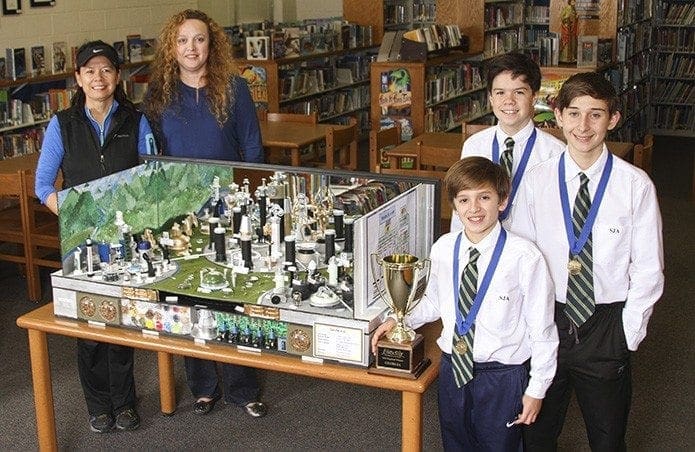 Photo By Michael Alexander
Photo By Michael AlexanderAtlanta
St. Jude the Apostle team wins state Future City competition
By GRETCHEN KEISER, Staff Writer | Published February 5, 2016
ATLANTA—A team from St. Jude the Apostle School in Sandy Springs took first place in this region of the Future City competition on Jan. 30 and will represent Georgia in the national competition later this month.
Forty middle school teams from 19 schools in the state took part in the engineering competition, where students design a future city based on a particular challenge, utilizing computer, math, science, engineering, design, writing and imaginative skills. Kennesaw State University hosted the event.
A team from Queen of Angels School in Roswell took second place.
This year’s challenge for the future engineers was to explore the theme of “Waste Not, Want Not,” and design an innovative, citywide solid waste management system for their future city that is safe, environmentally sound and energy efficient.
In the Future City competition, students design a virtual city, write a 1,500-word essay, build a physical model of a section of their city, and give a seven-minute presentation. These elements document the team’s progress through the engineering design process and showcase the team’s city of the future. Teams are judged and scored on all elements.
St. Jude’s winning team “GeoNexus” is made up of students Patrick McDonald, Peter Montesi and Diego Umana and was mentored by Cathy McDonald. In addition to placing first in the competition, “GeoNexus” won awards for the best physical model, best team presentation, best city description based on the essay, architectural excellence, most innovative construction techniques and best land surveying practices.
McDonald, their mentor, said, “Future City has been an educational experience not only in engineering principles, city infrastructure and problem-solving, but also in perseverance, writing skills, building skills, presentation skills and overall team-building experiences.”
The team will travel to Washington, D.C., Feb. 13-17 to represent Georgia in the national competition.
St. Jude’s second team in the competition was “Eco Stadt,” made up of students Eli Gearheard, Tyler Goforth and Conner Scholze, mentored by Earl Mayfield, Eli’s grandfather.
Queen of Angels teams
Taking second place was team “Aestuarium” from Queen of Angels School, made up of students Emma Jacobs, Ron Miller and Jessica Sobieski and mentored by Cindy Miller. The team also won awards for most accessible city and most sustainable food production system.
Team “Mizu No Miyaku” from Queen of Angels School won an award for most innovative design of infrastructure. The team includes students Piers Dudar, Bryce Jeong and Connor McGarigle and is mentored by Joe Dudar and Jean Rearick.
St. Mary’s teams
Four teams competed from St. Mary’s School in Rome, including “Shell City,” made up of students Nolan Kelley, John Lucas Todd, Kelley Anne Smith and Hannah Vick-Cortina; “Glomaltertay,” made up of students Gloria Murray, Marin Kinsey, Tayler Barnes and Walter Echanique; “Orchid City,” made up of students Ashlee Bailey, Lily Huynh, Gabriel Jones and Blake Collier; and “Phantasia,” made up of students Lauren Wilkes, J.C. Tan, Ivy Le and Ryan Acree. Becky Smyth, a city of Rome employee, mentored the teams.
The teachers involved with their respective Future City teams are Eleonora Straub at St. Jude, Cristina Zimmer at Queen of Angels and Julie McCormick and Kelly Armstrong at St. Mary’s, who teach science and math respectively.
Judges included KSU faculty members and deans from the College of Architecture and Construction Management, College of Engineering and College of Computer Software Engineering.